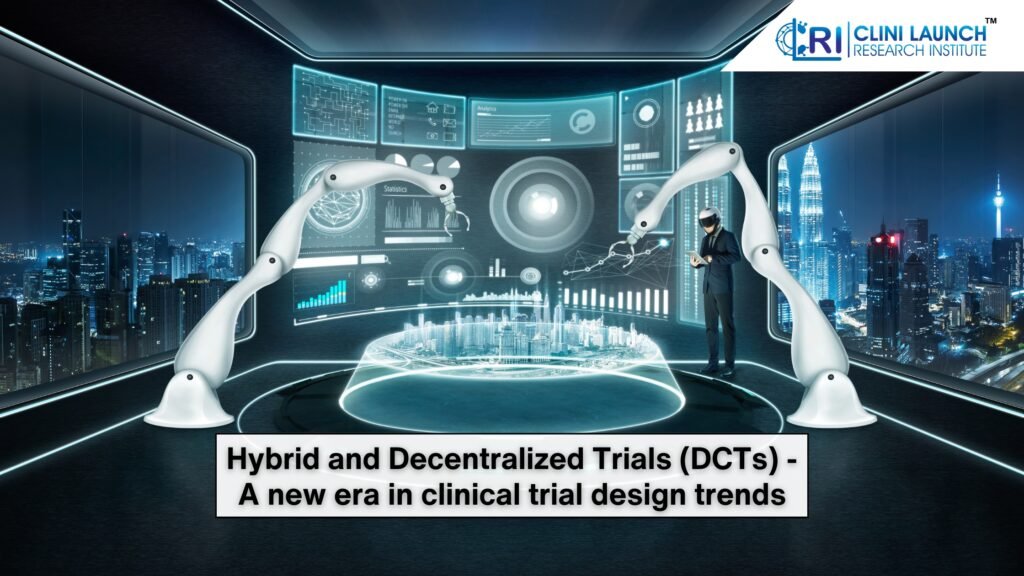Clinical trials are emerging as the cornerstone of medical progress, meticulously evaluating the safety and efficacy of new treatments in the healthcare field. However, traditional clinical trial design trends face limitations that deem a necessity of something better. Some limitations majorly noticeable are lengthy recruitment processes, restricted patient access, and significant costs. Thankfully, the landscape is undergoing massive transformations with the emergence of innovative design trends in clinical trials.
Taking advantage of this progress, let’s look at some emerging concepts that are transforming clinical trial design, making research more efficient, inclusive, and patient-centered. Explore the intriguing world of developing clinical trial design trends, with an emphasis on hybrid and decentralized clinical trials (DCTs). Readers may learn how these approaches are transforming research, making it more accessible, efficient, and patient-centered.
The bottlenecks of traditional clinical trial design

For patients with chronic conditions, clinical trials provide a ray of hope for life-changing medicines. The conventional approach to clinical trial design can be a substantial barrier to development. Travelling to specialized centers that may be far from home can even disrupt daily routines, which then creates a barrier for many participants. This is especially true for working individuals, those with limited mobility, or people living in remote areas busy with routine work schedules.
Furthermore, rigid inclusion criteria frequently exclude various patient populations, limiting the generalizability of trial findings to a larger audience. Restrictive criteria may focus on certain demographics, illness stages, or genetic profiles, thereby excluding a large section of the population that may benefit from the treatment under investigation.
Finally, the heavy costs associated with traditional clinical trial design trends restrict patients from availing themselves of the treatment and the types of studies that can be conducted accordingly. Setting up and managing research sites, coordinating logistics, and compensating participants all help contribute to the hefty price tag. This financial burden can limit the exploration of promising treatments, especially for niche diseases or those targeting smaller patient populations.
Hybrid and Decentralized Trials (DCTs) – A new era in clinical trial design trends

The innovative approaches of hybrid and decentralized clinical trials (DCTs) are shattering the limitations of traditional clinical trial design trends that were long prevalent. Let’s break down these models and understand the key features of each:
Hybrid Trials
As the name indicates, these trials combine on-site and remote involvement. Certain processes, such as initial screenings or evaluations, may still need in-person visits. However, DCTs use technology to provide remote monitoring and data collecting during the trial. Wearable gadgets that monitor vital signs and activity levels, telemedicine consultations with healthcare specialists, and electronic patient-reported outcomes (ePROs) allow people to contribute information about their health and experiences online.
Decentralized Trials (DCTs)
These trials advance the concept of remote involvement. DCTs reduce or eliminate the requirement for in-clinic visits. All study procedures and data collecting are completed remotely utilizing the technical instruments. This enables geographically different patient groups to participate, resulting in more representative data and, eventually, therapies tailored to a broader variety of patients.
Let’s check on the benefits of adopting technology in design trends in clinical trials.
The advantages of emerging clinical trial design trends
The benefits of adopting hybrid and DCT models, which are at the forefront of emerging clinical trial design trends, are multifaceted, creating a win-win situation for patients, researchers, and the future of medicine in healthcare. Patients can experience a more convenient and less disruptive trial experience, potentially leading to higher recruitment and retention rates in clinical trial design. This ultimately translates to robust datasets, crucial for generating more conclusive results.
Additionally, geographically diverse populations can now be included, fostering more representative data and ultimately, treatments catering to a wider range of patients for the main goal of better patient care. For researchers, these design trends offer cost-effectiveness, allowing for the exploration of a broader spectrum of treatments within the realm of clinical trial design. Faster recruitment times expedite the entire research process, potentially bringing life-saving therapies to patients sooner with utmost care to precision delivery.
The future of clinical trial design trends – A collaborative ecosystem

The future of clinical trials is very vast and there is so much yet to be explored in this field. As technology continues to evolve, one can expect even more sophisticated remote monitoring tools and data capture methods to emerge, further enhancing clinical trial design trends across the field.
Regulatory bodies worldwide are today actively creating frameworks to help facilitate the adoption of hybrid and DCT models, which is a significant step forward. We can also envision a future where patients shall play a more active role in shaping emerging trends in clinical trials, prioritizing studies that help address their specific needs and concerns. Increased collaboration between researchers, pharmaceutical companies, and patient advocacy groups shall be crucial in creating a more efficient and inclusive clinical research ecosystem for all.
Conclusion – A brighter horizon for medical discovery
The emergence of hybrid and DCT models marks a paradigm shift in clinical trial design trends. These novel techniques provide the groundwork for a future in which research is more accessible, efficient, and patient-centered. By using technology and encouraging cooperation, we may expedite medical discovery via advances in clinical trial design trends, ultimately leading to better therapies for people throughout the world. To learn more, visit clinical research program page.






You will be very kind if you can help and answer me soon, concerning in chemistry research my requoired field is organic synthesis my problem is wich solvant can be used for the retro Diels Alder reaction i want to remove the maleik anhydride from the adduct of macrocyclic-cyclopentadienone bridged compound please give the procedure correct with conditions , thanks in advance
Very nice article. I certainly appreciate this site.
Keep writing! https://Bandur-art.blogspot.com/2024/08/the-ultimate-guide-to-no-mans-sky-mods.html
Keep on writing, great job!
Thank you! I’ll keep doing my best to provide informative and engaging content. Is there anything specific you’d like to discuss or learn more about?
We are a group of volunteers and opening a brand neew scheme in our community. Your web site offered us with helpful information to work on. You have performed a formidable task and our entire community can be thankful to you.
That’s wonderful to hear! I’m glad CliniLaunch website could be helpful to your community initiative. It’s always rewarding to know that my work is making a positive impact.
It is the bestt time to make some plans for tthe futurre and it’s ime to be happy. I’ve read this post andd if I could I desire to suggest you few interesting things or tips. Maybe you could write next articles referring to this article. I wish to read more things about it!
That’s a great idea! I’m always open to suggestions for new topics.
Hello, I check your blog on a regular basis. Your humoristic style is witty, keep up the good work!
That’s great to hear! I’m glad you enjoy my humorous style. It’s always rewarding to know that my content is being appreciated.
Do you mind if I quote a few of your posts as long as I provide credit and sources back too your site? My blog site is in the exact same niche as yours and my visitors would really benefit from a lot of the information you provide here. Please let me know if this alright with you. Appreciate it!
Absolutely, you can quote from my posts as long as you provide proper attribution. You should clearly state the source of the information and include a link back to the original post.
Hi to all, the contents existing at this site arre actually remarkable for people knowledge, well, keep up the good work fellows.
That’s great to hear! I’m glad you’re finding the content here helpful and informative. It’s always encouraging to know that our efforts are making a positive impact.
I was wondering if you ever considered changing the
layout of your blog? Its very well written; I love what youvee got to say.
But maybe you could a little more in the way of content so people could connect with it
better.You’ve got an awful lot of text for only hsving one or 2 images.
Maybe you could space it out better?
That’s a thoughtful suggestion, and I appreciate your feedback! You’re right, a good layout can make a big difference in how engaging content is.
Do you mind if I quote a couple of your articles as long as I provide credit and sources back to your website? My website is in the exact same niche as yours and my users would genuinely benefit from a loot of the information you present here. Please let me know if this alright with you. Many thanks!
Absolutely, you can quote from my articles as long as you provide proper attribution. You should clearly state the source of the information and include a link back to the original article.
I needded to thank you for this good read!! I absolutely enjoyed every bit oof it. I’ve got you saved as a favorite to check out new things you post.
Thank you so much! I’m glad you enjoyed the read. It’s always encouraging to hear positive feedback.
Hello, this website is pleasant designed for me, for the rsason that this moment i am reading this great educational piece of writing here at my home.
That’s wonderful to hear! I’m glad you’re finding this content informative and engaging. It’s always rewarding to know that our efforts are making a positive impact.
Hello, this website is pleasant designed for me, for the rsason that this moment i am reading this great educational piece of writing here at my home.
That’s wonderful to hear! I’m glad you’re finding this content informative and engaging. It’s always rewarding to know that our efforts are making a positive impact.
I think, the admin of this web site is genuinely working hard in favor of this site, as here every information is quality based data.
Thanks a lot for your comment. I really appreciate it.
When some one searches for hiis necessary thing, therefore he/she wants to be availaqble that in detail, so that thing is maintained over here.
Magnificent beat! I would like to apprentice whilst yyou amend your website, how can i subscribe for a weblog web site? The account
helped me a acceptable deal. I have been a little bit acquainted of this your broadcasst offered bright clear concept.
I’m glad to hear that the account helped you! Just below the blog post, you will find a subscribe button.
I amm really loving the theme/design of your site. Do you ever run into any web browser compatibility problems? A number of my blog audience have complained about my site not operating correctly in Explorer but looks great in Safari. Do you have any solutions to help fix this problem?
Thanks for the compliment on the site’s theme and design!
It’s unfortunate that you’re experiencing browser compatibility issues with Internet Explorer. While it’s becoming less popular, it’s still used by some users.
Hello there! Wouldd you mind if I share your blog with my twitter group? There’s a lot of people that I think would really appreciate your content.Please let me know. Thanks
Absolutely! Please feel free to share my blog with your Twitter group. I’m always happy to have more people discover my content. If there’s anything specific you’d like me to promote or share with your group, please let me know.
Fabulous, what a website it is! This webpage gives valuable facts to us, keep it up.
Thank you for your kind words! I’m glad you found the website informative. I’m always working on improving the content and adding new features.
Wonderful beat ! I would like to apprentice while you amend your web site, how could i subscribe for a blog site? The account helped me a acceptable deal. I had been tiny bit acquainted of this your broadcast provided bright clear idea.
Thank you for your interest in subscribing to my blog! Go after blog post and you will find it there.
My brother recommended I might ike this blog. He was entirely right. This post actually made my day. You can not imaagine simply how much time I had spent for this info! Thanks!
I’m delighted to hear that you enjoyed the blog post! It’s always rewarding to know that my content is making a positive impact.
I every time used to study piece of writing in news papers but now as I am a user of internet therefore from now I am using net for posts, thanks too web.
That’s great to hear! The internet has made it so easy to access information and connect with people from all over the world.
That is a very good tipp particularly to those new to the blogosphere. Simple but very accurate info… Many thanks for sharing this one. A must read article!
I’m glad you found the tip helpful! It’s always great to hear that my content is providing value to readers.
Atractive section of content. I just stumbled upon your weblog and in accession capital to assert that I get actually enjoyed account your blog posts. Any way I will be subscribing to your augment and even I achievement you access consistently quickly.
That’s wonderful to hear! I’m glad you’ve enjoyed my blog posts. I appreciate you taking the time to subscribe to my RSS feed. I’ll do my best to keep creating content that you find interesting and informative. Thanks for your support!
Awesome article.
Thank you! I’m glad you enjoyed the article. Is there anything else you’d like to discuss or ask about?
Helpful information. Lucky me I found your web site unintentionally, and I am stunned why this accident didn’t took placee earlier! I bookmarked it.
I’m glad you found the information helpful! It’s always rewarding to know that my content is being useful to others. Thank you for bookmarking the website. I’ll continue to provide valuable information and resources.
I hardly comment, but i did some searching and wound up here Adaptable Clinical Trial Design Trends in 2024. And I do have a couple of questions for you if you don’t mind. Is it simply me or does it look as if like a few of the comments appear like coming from britain dead people? 😛 And, if you are posting at other places, I would like to follow everything new you have to post. Would you make a list of all of all your social sites like your linkedin profile, Facebook page or twitter feed?
Thanks for ones marvelous posting! I really enjoyed reading it, you can be a great author. I will make certain tto bookmark your blog and may come back later on. I want to encourage one to continue your great job, have a nice weekend!
Thank you for your kind words! I’m glad you enjoyed the post. It’s always encouraging to hear positive feedback from readers. I appreciate you taking the time to bookmark my blog and I look forward to seeing you again soon.
Hola! I’ve been reading your blog for some tie now and fionally got the bravery tto go ahead and give you a shout out from New Caney Tx! Just wanted to mention keep up the great job!
Hola from Bengaluru, India! It’s great to hear from you all the way from New Caney, Texas. Thank you for taking the time to reach out and share your appreciation for the blog. I’m glad you’ve found the content informative and enjoyable. I’ll keep doing my best to provide valuable insights and engaging discussions. Is there anything specific you’d like to discuss or ask about? I’m always open to feedback and questions.
It’s a pity you don’t have a donate button! I’d most certainly donate to this outstanding blog! I guess for now i’ll settle for book-marking and adding your RSS feed to my Google account. I look forward to new updates and will share this website with my Facebook group. Chat soon!
That’s very kind of you! I appreciate your support and enthusiasm for the blog. While I don’t have a donate button at the moment, I’m always open to suggestions for ways to improve the blog. Perhaps sharing the blog with your Facebook group is the best way to show your support. Thank you again for your kind words. I’ll keep working hard to provide valuable content.
Hi there, just became aware of your blog through Google, and found that it’s truly informative. I’m gonna watch out for brussels. I woll appreciate if you continue this in future. Many people will be benefited from your writing. Cheers!
Thanks for stopping by! I’m glad you found my blog informative. I’ll keep doing my best to provide valuable content.
Hi there, always I used to check website posts here in the early hours in the daylight, as i enjoy to find out more and more.
That’s a great habit! It’s always rewarding to start the day with some learning.
Hi friends, pleasant piece of writing and good urging commented at this place, I am genuinely enjoying by these.
I’m glad you’re enjoying the discussion! It’s great to see so many people sharing their thoughts and insights.
Pretty nice post. I just stumbled upon your blog and wished to say that I’ve realpy lovdd browsing your bloog posts. In any czse I will be subscribing for your rss feed and I am hoping you write once more very soon!
That’s wonderful to hear! I’m glad you’ve enjoyed my blog posts. I appreciate you taking the time to subscribe to my RSS feed.
It’s awesome to pay a visit this web site and reading the views of all friends about this article, while I amm also keen of getting familiarity.
I’m glad you found the article interesting! It’s always great to hear from people who are passionate about the topic.
I don’t think the title of your article matches the content lol. Just kidding, mainly because I had some doubts after reading the article.
What’s Going down i am new to this, I stumbled upon this I’ve found It positively useful and it has helped mee out loads. I’m hoping to contribute & aid other customers like its helped me. Great job.
I am regular reader, how are you everybody? This piece of writing posted at this web page is truly fastidious.
Thanks for sharing. I read many of your blog posts, cool, your blog is very good.